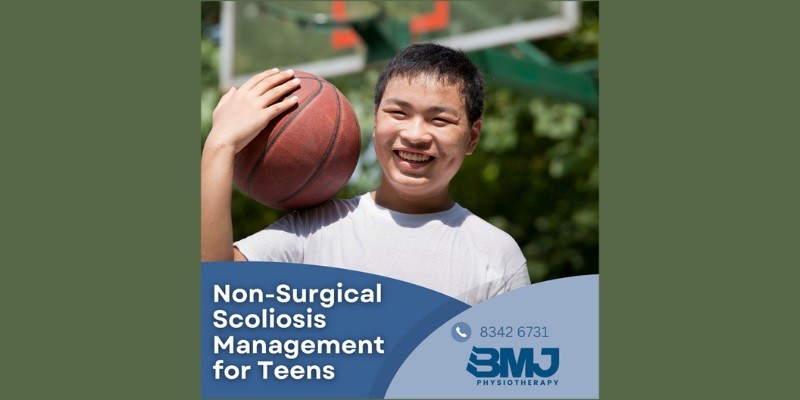Last Updated on June 18, 2025 by Jaclyn A. Neeley
Scoliosis affects many adolescents in Singapore. It can often feel overwhelming, especially when exploring treatment options. Non-surgical scoliosis management offers an effective alternative that empowers teens with the help of specialised physiotherapy.
Physiotherapy provides tailored exercises that address the curvature of the spine and improve overall posture and strength. This form of treatment focuses on enhancing the body’s natural abilities, making it a viable option for those looking to avoid surgery.
In Singapore, many teens have successfully managed their Scoliosis through non-surgical means. By engaging in physiotherapy, they gain control over their treatment and can continue their daily activities with greater confidence and comfort.
Understanding Scoliosis in Adolescents
Adolescent scoliosis often goes unnoticed until physical symptoms such as uneven shoulders or waistline asymmetry appear. Early detection and proper monitoring can significantly influence the progression and management of the condition.
Types and Causes of Scoliosis
Adolescent Idiopathic Scoliosis is the most common type, typically developing around the onset of puberty without a known cause. It is identified by a noticeable spinal curvature occurring in otherwise healthy teenagers.
Congenital Scoliosis arises due to spinal malformations present at birth. This type is observed early and may require close monitoring and sometimes surgical intervention based on the severity.
Neuromuscular Scoliosis occurs in teens with underlying neuromuscular conditions like cerebral palsy or muscular dystrophy. The spinal curvature in these cases tends to be more rigid and progresses more rapidly.
Understanding the specific type of Scoliosis is crucial for tailoring the treatment approach, which can range from exercises to bracing or even surgery.
The Importance of Early Detection and Monitoring
Early Detection is key in managing Scoliosis effectively. Visible symptoms include uneven shoulders, prominent shoulder blades, or waistline asymmetry. Regular school screenings and routine physical exams are essential.
Monitoring involves physical assessments and X-rays to track the progression of the spinal curve. This helps determine the risk of progression and make informed decisions about treatment options.
Teenagers still growing are more at risk as their skeletal maturity hasn’t been reached. Thus, continuous monitoring is vital until they reach skeletal maturity, ensuring any progression is managed promptly to avoid severe deformities or complications.
Assessing Treatment Options and Goals
Non-surgical treatments, including physiotherapy, are the first line of approach. These help improve posture and strengthen muscles. Bracing is recommended to prevent further curvature in growing teens, typically during skeletal immaturity phases.
Regular Observation is critical, particularly for mild curves, ensuring any changes in the spinal curvature are detected early. This may include frequent physical assessments and periodic X-rays.
Quality of Life and function are primary goals in treatment plans. Reducing pain, ensuring the ability to perform daily activities, and minimising the aesthetic impacts of Scoliosis are key considerations.
A well-tailored Treatment Plan aims to manage symptoms effectively, prevent progression, and enhance overall well-being for adolescents with Scoliosis.
Physiotherapy as an Empowering Non-Surgical Solution
Physiotherapy offers teens with Scoliosis a proactive and non-invasive way to manage their condition. Emphasising exercises and postural awareness, it equips them with the tools needed to alleviate discomfort and improve quality of life.
Core Components of Physiotherapy for Scoliosis
The core of physiotherapy for Scoliosis includes a variety of exercises designed to increase flexibility, improve core stability, and strengthen muscles. Stretching plays a crucial role in balancing muscle imbalances, while core-stabilising exercises support the spine.
Physical therapists customise plans to the individual’s needs, ensuring targeted intervention. These plans often include postural awareness techniques, helping patients identify and correct poor postural habits. The goal is to reduce pain and discomfort, improve functionality, and promote self-management.
The Schroth Method: Customised Exercise Programs
The Schroth Method is a renowned physiotherapy approach for Scoliosis. It involves customised exercise programmes tailored to the unique curvature of each patient’s spine. These Schroth exercises focus on rotational breathing, muscle imbalances, and specific postural corrections.
Breathing techniques help expand the chest cavity and improve lung function. Postural awareness and stretching exercises realign the spine and mitigate the symptoms. By following a structured program, patients can experience significant improvements in their posture and spinal alignment.
Incorporating alternative therapies alongside physiotherapy can enhance the management of Scoliosis. Options like Pilates and yoga are beneficial in improving flexibility and core strength. Manual therapy may also be employed to release tight muscles and improve mobility.
Electrical stimulation can assist in muscle re-education and reduce pain. Lifestyle modifications such as maintaining a healthy weight and incorporating regular exercise are vital. These strategies not only aid in physical rehabilitation but also empower teens to take control over their pain management and everyday life.
BMJ Physiotherapy is a specialised clinic dedicated to helping teens aged 12 to 20 manage and overcome scoliosis. Led by Physiotherapist Darek, who formerly headed the physiotherapy department at Singapore’s Changi Hospital, our team brings unparalleled expertise and experience to each patient. We understand the unique challenges that scoliosis presents during adolescence, and we are committed to providing targeted, effective treatments that support healthy growth and development.
With seven clinics across Singapore, BMJ Physiotherapy is the trusted choice for families seeking specialised care for their teens. Our personalised approach ensures that every young patient receives the attention and treatment they need to build a strong, confident future.


